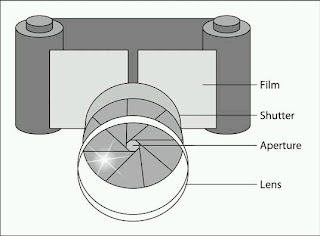Before taking a look at how digital cameras control exposure, it helps to understand how a film camera does the job. Even though digital cameras don't function in quite the same way as a film camera, manufacturers describe their exposure control mechanisms using traditional film terms, hoping to make the transition from film to digital easier for experienced photographers.
Figure 2-12 shows a simplified illustration of a film camera. Although the specific component design varies depending on the type of camera, all film cameras include some sort of shutter, which is placed between the film and the lens. When the camera isnít in use, the shutter is closed, preventing light from reaching the film. When you take a picture, the shutter opens, and light hits the film. (Now you know why the little button you press to take a picture is called the shutter button and why people who take lots of pictures are called shutterbugs.)
You can control the amount of light that reaches the film in two ways: by adjusting the amount of time the shutter stays open (referred to as the shutter speed ) and by changing the aperture. The aperture, labeled in Figure 2-12, is a hole in an adjustable diaphragm set between the lens and the shutter. Light coming through the lens is funneled through this hole to the shutter and then onto the film. So if you want more light to strike the film, you make the aperture bigger; if you want less light, you make the aperture smaller.
 |
| Figure 2-12: A look at the shutter and aperture in a traditional film camera. |
The size of the aperture opening is measured in f-numbers, more commonly referred to as f-stops. Standard aperture settings are f/1.4, f/2, f/2.8, f/4, f/5.6, f/8, f/11, f/16, and f/22.
Contrary to what you may expect, the larger the f-stop number, the smaller the aperture and the less light that enters the camera. Each f-stop setting lets in half as much light as the next smaller f-stop number. For example, the camera gets twice as much light at f/11 as it does at f/16. (And here you were complaining that computers were confusing!) See Figure 2-13 for an illustration that may help you get a grip on f-stops.
 |
| Figure 2-13: As the f-stop number decreases, the aperture size grows and more light enters the camera. |
Shutter speeds are measured in more obvious terms: fractions of a second. A shutter speed of 1/8, for example, means that the shutter opens for one-eighth of a second. That may not sound like much time, but in camera years, it's in fact a very long period. Try to capture a moving object at that speed and you wind up with a big blur. You need a shutter speed of about 1/500 to capture action clearly.
On cameras that offer aperture and shutter speed control, you manipulate the two settings in tandem to capture just the right amount of light. For example, if you're capturing fast action on a bright, sunny day, you can combine a fast shutter speed with a small aperture (high f-stop number). To shoot the same picture at twilight, you need a wide-open aperture (small f-stop number) in order to use the same fast shutter speed.

Post a Comment